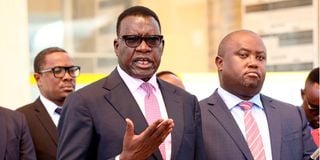Ensure Western Kenya is lit

Energy and Petroleum Cabinet Secretary Davis Chirchir (left), flanked by Principal Secretary Alex Wachira, speaks to the media at Kawi House, Nairobi on December 11, 2023 regarding the nationwide power outage that occurred on Sunday, December 10, 2023.
The recent three consecutive countrywide blackouts once again exposed the delicate nature of the national grid. The problem is lack of investment in the transmission network, stated Energy Cabinet Secretary Davis Chirchir. Crucial lines are incomplete.
Demand in western Kenya is more than the capacity of the lines feeding the region can carry, hence overloads. Loadshedding has been mooted for the long-suffering Western grid. Resolution of the crisis via loadshedding or controlled blackouts is aimed at saving the grid from collapse during such events. Notably, the overload on the line occurred on a weekend night, a period of low activity. A productive weekday will, with the same parameters, be worse.
That means a 20-60 megawatt unserved consumer demand in Western, pointing to inadequacy of power in a region that only has Sondu Miriu and Sangoro plants generating power locally. More such installations in Western have been proposed but few built due to a multiplicity of issues in the sector—indecision and, most apparently, moratoriums placed on power purchase agreement (PPAs).
Should the visibly productive and growing region suffer rolling loadshedding for at least 20 months?
Our focus in the electricity sector is overly biased towards the technical parameters. We focus on saving the grid from collapse, a noble cause, but leave the curtailed customer to their devices. Productive consumers thus resort to shutting down some shifts, layoffs or engaging in expensive generation through diesel gensets. That discourages growth of demand.
There should be an active encouragement of establishments to install captive power systems in Western. The region is endowed with solar, hydro and biomass energy, hence able to be harnessed for self-supply.
The grid has momentarily failed to supply their needs. Rather than use expensive diesel gensets, establishments should be facilitated and encouraged to install own generation. Private sector funding is available for the initiatives and technologies like solar can be installed in much less than the loadshedding period, partially standing in the gap.
We should also explore the ability of the grid to move power generation sources within Western, which has always needed voltage support; hence the Muhoroni gas plant and use of Ugandan power.
Thermal power plant
The Muhoroni plant is rightfully set for decommissioning, having served in Mombasa, Nairobi and Muhoroni for over 30 years. It runs on kerosene and is not modern. There is a need to install an appropriately sized and -located thermal power plant in Western as a short-term measure and long-term support for the grid locally. This, coupled with the plans for solar, biomass and hydro plants and battery storage, will avert future localised shortages.
Distribution of generation assets is good from a cost and security of supply perspective. But to increase productivity, create jobs and boost economic opportunities, exports and tax revenue, we must put all options on the table to ensure the consumers in Western suffer as little disturbance as possible.
After all, in the 20 or more months that it will take to get the transmission lines built, the economy would have grown, hence increased local demand, and if the nationwide supply is constrained as a result of the delays occasioned by various moratoria, the lines may arrive with insufficient power.
The option of curtailing demand and, hence, productivity should be a pained one—after all measures have been taken to ensure a steady supply.
Mr Aluru is the CEO of Electricity Sector Association of Kenya (ESAK). [email protected].





